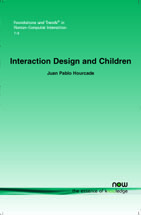Interaction Design and Children
By Juan Pablo Hourcade, University of Iowa, USA, hourcade@cs.uiowa.edu
Abstract
Children are increasingly using computer technologies as reflected in reports of computer use in schools in the United States. Given the greater exposure of children to these technologies, it is imperative that they be designed taking into account children's abilities, interests, and developmental needs. This survey aims to contribute toward this goal through a review of research on children's cognitive and motor development, safety issues related to technologies and design methodologies and principles. It also provides and overview of current research trends in the field of interaction design and children and identifies challenges for future research.
To understand children's developmental needs it is important to be aware of the factors that affect children's intellectual development. This survey analyzes the relevance of constructivist, socio-cultural, and other modern theories with respect to the design of technologies for children. It also examines the significance of research on children's cognitive development in terms of perception, memory, symbolic representation, problem solving, and language. Since interacting with technologies most often involves children's hands this survey also reviews literature on children's fine motor development including manipulation and reaching movements. Just as it is important to know how to aid children's development it is also crucial to avoid harming development. This survey summarizes research on how technologies can negatively affect children's physical, intellectual, social, emotional, and moral development. Following is a review of design methodologies for children's technologies organized based on the roles children may play during the design process including a description of cooperative inquiry and informant design methods. This is followed by a review of design principles obtained through experiences in developing technologies for children as well as research studies. It includes design principles related to visual design (e.g., icons, visual complexity), interaction styles (e.g., direct manipulation, menus), and the use of input devices (e.g., pointing, dragging, using mouse buttons). The latter half of this survey summarizes research trends in the field of interaction design and children, grouping research efforts in the following areas: supporting creativity and problem solving, supporting collaboration and communication, accessing, gathering and exploring content, learning from simulations, supporting children with special needs, interacting with intelligent characters, supporting healthy lifestyles, learning skills, mobile, tangible, and ubiquitous computing, and designing and evaluating technologies. This survey concludes by formulating research challenges for the future and identifying three information age "plagues" children are in danger of facing in the near future.
Interaction Design and Children
Given the greater exposure of children to computer technologies, it is imperative that they be designed taking into account children's abilities, interests, and developmental needs. Interaction Design and Children aims to contribute towards this goal through a survey of research on children's cognitive and motor development, safety issues related to technologies and design methodologies and principles. It also provides an overview of current research trends in the field of interaction design and children and identifies challenges for future research. Interaction design and children is a young field, but it has strong foundations to build on. Decades of work on child development provide a starting point. Research on children's motor skills can guide the development of low-level interactions. An awareness of the risks that technologies may pose provides warning signs for areas to stay away from. Following empirically based guidelines can ease the way. But many challenges remain and Interaction Design and Children is a valuable tool for those who want to become familiar with the field as well as for those looking to get up to date with current research on interaction design and children.
